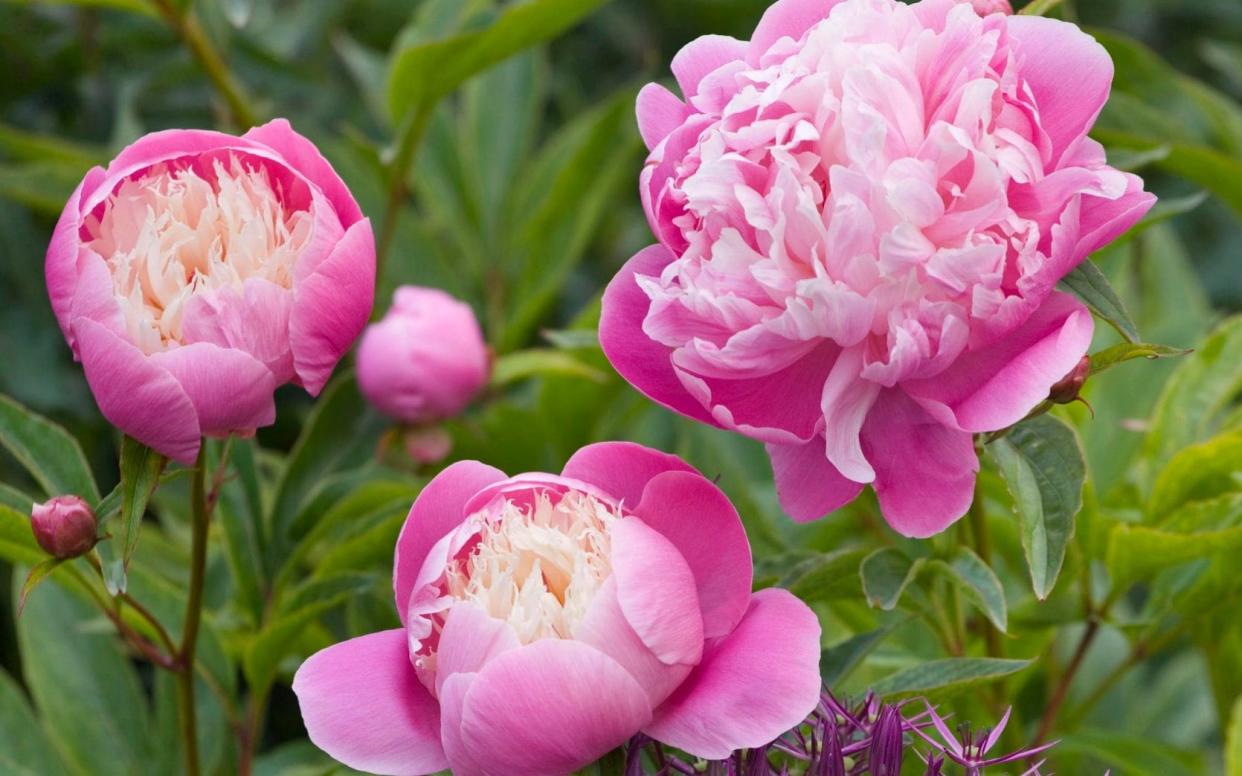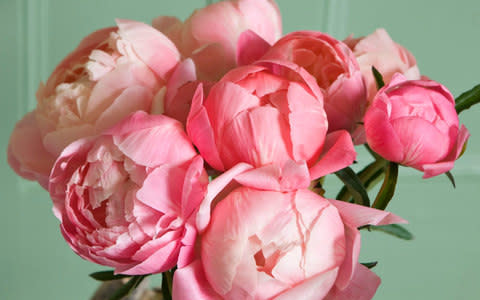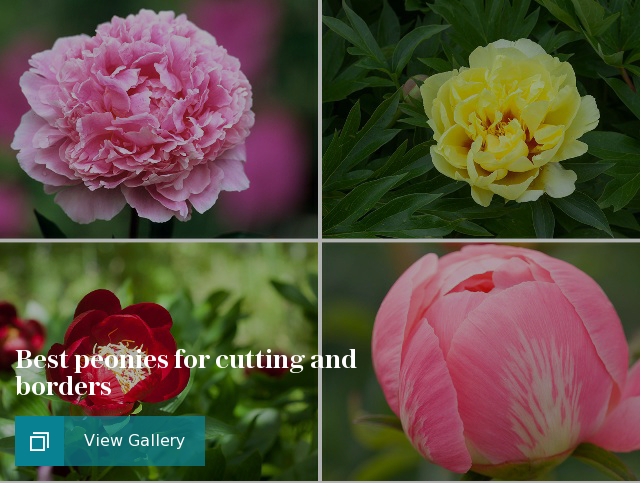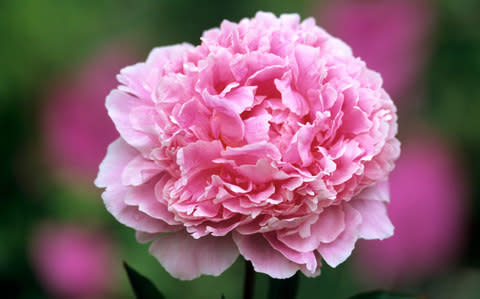Peonies: more, better and bigger flowers for colour in early summer

October is the ideal time to plant bare-root peonies and divide and move any established plants. Ignore old wives’ tales that peonies should not be moved – by August these early summer flowerers are entering dormancy so barely notice disturbance in autumn.
Peony lovers currently have a unique opportunity to compare 180 varieties on trial at RHS Wisley. The trial began in 2016, so it’s still early days – but it will run until 2020 so is well worth a visit next season. You’ll find them on the Portsmouth Field, on the far side of Battlestone Hill, and on Seven Acres, close to the main restaurant.

The plants have been sent in by British peony specialists, with a few from China, Ireland and the Netherlands. Expert growers, including Claire Austin, Billy Carruthers and Jo Bennison, are on the judging panel and I have gleaned a few early pointers from their notes on what is performing well.
American innovations
Of the 111 P. lactiflora hybrids on trial, two have already impressed the panel and could get the ultimate accolade of an Award of Garden Merit. Everybody loves ‘Hari-ai-nin’, sent in by the Irish nursery Leamore. The Japanese-style flowers have a bowl of wine-red petals surrounding deep red, upright stamenoid petals lightly flecked in gold. The panel observed that the strong-stemmed flowers didn’t fade and they died well.
‘Hari-ai-nin’ is on the website of Prairie Star Flowers (they call it 'Hariainin'), a list produced by a research facility based at Kansas University. It specialises in perennials and annuals able to tolerate the continental climate typical of the heartland of the United States – extremely cold winters and hot, humid summers.

It’s one of the reasons why so much 20th and 21st-century peony breeding happens in America. The climate kills off many plants, but peonies thrive and are widely used in landscape design and gardens. The further north you go, the later the peonies flower.
The American ‘Lady Orchid’, raised in 1942 by Myron Bigger (1902-1998) has also caught the Wisley judges’ eye. The panel admires its blue-green foliage and fully double, fragrant pink flowers that fade to a paler pink.
Bigger was a cut-flower producer, not a nurseryman, and he harvested between 72,000 and 84,000 flowers a year from his eight-acre patch in Topeka, Kansas. The most popular American peony for cutting is ‘Charlie’s White’, raised in 1951 at the Klehm family nursery near Chicago. However, it hasn’t flowered on the trial this year and has never flowered well for me, either.

The third generation of Klehms, Charlie’s son Carl, championed coral-tinted peonies, including ‘Coral Charm’ and ‘Coral Sunset’. Both have a habit of fading from coral to apricot and then to clotted cream. ‘Coral Charm’ has larger flowers than ‘Coral Sunset’; those of the similar ‘Pink Hawaiian Coral’ are even larger. All three are vigorous on the trial, although be aware that coral-pink peonies are not the most fragrant.
‘Coral Sunset’ is reputedly more floriferous than ‘Coral Charm’. It produced “lots of stunning coral-pink flowers which faded to vanilla ice cream”, according to the panel. They also admired the “nice furry carpels”.
Coral-tinted peonies need a warmer position, in my experience, to flower well. They can look insipid on their own because the flowers fade to clotted-cream, so use blue hardy geraniums such as ‘Orion’, to add extra vibrancy, and provide a backdrop of warm-tinted apricot and yellow roses to carry on the peach and apricot theme.

Japanese influence
The trial also has nine intersectional or Itoh Hybrids. These woody-stemmed hybrids are half tree peony and half herbaceous peony, so they keep a woody presence above ground in winter and many have larger bowl-shaped flowers with showy stamens. They’re still relatively rare and expensive, although prices are coming down.
Toichi Itoh of Japan made 1,200 crosses before he finally managed to produce seedlings from the yellow tree peony ‘Alice Harding’ and the double white P. lactiflora ‘Kakoden’ in the mid-Sixties. Sadly, Itoh died before his seedlings flowered, but American breeder Louis Smirnow introduced them into America and their arrival encouraged other breeders.

Three Itoh hybrids, or intersectional hybrids, have been awarded the American Peony Society Award for Landscape Merit: the lemon-yellow ‘Bartzella’, the golden-yellow ‘Garden Treasure’ and the greenish-yellow ‘Prairie Charm’.
According to the Wisley judges, ‘Bartzella’ “is the most dramatic of the Itoh hybrids” and it will flower for five or six weeks. The panel chairman, David Foreman, has chosen it as his favourite for its ability to produce lots of large lemon-yellow flowers.
It’s a show-stopper in my garden, too. In fact, it is almost too showy because the large lemon flowers, some 6in or so in diameter, jump out of the border. Itoh Hybrids may be best used as statement plants at the end of a border, or in a strategic position. They can also be grown in wilder areas of the garden as flowering shrubs.
Peonies for borders
Opt for P. lactiflora hybrids for cutting because some are early, others mid-season and others late, so you’ll get eight-10 weeks of picking. The smaller-flowered varieties produce most stems and ‘Sarah Bernhardt’, the most popular commercial cut-flower variety, performs really well although it’s often criticised by purists for its floppy habit.

Most pink and cream peonies are wonderfully fragrant and they’re excellent cut flowers. If picked at the “marshmallow stage”, when the buds are showing some colour and soft to the touch, they will last for two weeks. Cut peonies are thirsty and need lots of water, so don’t arrange them in florists’ foam. If you cut half an inch off the stems every day it will also help them to last longer.
In the flower border peonies are most suited to mingling with pastel-tinted, summer-flowering perennials and roses. Traditional pink- and cream-flowered peonies mix with all early-summer herbaceous perennials, including campanulas, lupins, the statuesque pink and white bleeding heart (Lamprocapnos spectabilis), all astrantias and the wine-red pincushions of Knautia macedonica.
Most peonies enter dormancy by August, and as a result their foliage looks positively jaded by the time late-season planting peaks in September.
Peonies are often used at RHS Chelsea, especially those that flower early in the season. These tend to have the May-flowering cottage garden peony (P. officinalis) in their bloodline. Andy Sturgeon used ‘Claire de Lune’ in 2012 and its highly pleated, buttermilk petals and golden boss of stamens astonished everyone. In 2013 it popped up again in Jo Thompson’s garden.


